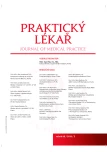Fournier gangrene – an example of multidisciplinary cooperation
Authors:
J. Richtarová 1,2; I. Satinský 2,3
Authors‘ workplace:
Ostravská univerzita v Ostravě Lékařská fakulta Ústav epidemiologie a ochrany veřejného zdraví Vedoucí: doc. MUDr. Rastislav Maďar, PhD., MBA, FRCPS
1; Nemocnice s poliklinikou Havířov Multioborová jednotka intenzivní péče Primář: MUDr. Igor Satinský, Ph. D.
2; Slezská univerzita v Opavě Fakulta veřejných politik Ústav ošetřovatelství Vedoucí: PhDr. Jana Haluzíková, Ph. D.
3
Published in:
Prakt. Lék. 2019; 99(3): 127-132
Category:
Case Report
Overview
Fournier’s gangrene represents a rare, but very serious and life-threatening inflammatory disease that is characterized as a necrotizing infection affecting deep layers of soft tissue in the area of the external genitalia, perineum and perianal area. An early diagnosis contributes to the improvement of the treatment results and the overall prognosis of the patient. Primarily based on a complete history and physical examination, the diagnosis results are the results of laboratory tests, imaging methods are also used to clarify the diagnosis. Microbiological diagnostics and regular monitoring of laboratory values, along with monitoring of hemodynamic parameters and organ functions, should not be omitted during treatment.
In connection with this disease it is necessary to hospitalize the patient in intensive care unit and with comprehensive treatment. Therapy consists of the application of broad-spectrum antibiotics, including early surgical intervention with removal of all necrotic tissues. All measures leading to hemodynamic patient stabilization (adequate infusion hydration) and prevention of the development of multi-organ dysfunction and multi-organ failure are important. One possibility of improving the therapeutic effect is the possibility of using hyperbaric oxygen therapy.
The aim of this article is to show on the example of the patient how the theoretical knowledge of this mostly polymicrobial infection is reflected in practice and how the disease is demanding for treatment and nursing care. To find the necessary information, the authors used literary sources from freely available and licensed databases and, at the same time, experience from their own workplace - Interdisciplinary Intensive Care Unit (MOJIP) of the Havířov Hospital was compared.
Keywords:
hyperbaric oxygen therapy – Fournier’s gangrene – multiple organ failure – debridement
Sources
1. Brož L, Kapounková Z, Pafčuga I, Švecová, C. Termický úraz jako příčina Fournierovy gangrény. Postgrad Med 2007; 9(7): 732–734.
2. Cundy TP, Boucaut HAP, Kirby CP. Fournier’s gangrene in a child with congenital genitourinary anomalies. J Pediatr Surg 2012; 47(4): 808–811.
3. Kolombo I, Poršová M, Pabišta R, a kol. Fournierova gangréna v současné urologické praxi. Urol praxi 2011; 12(4): 234–237.
4. Perry TL, Kranker LM, Mobley EE, et al. Outcomes in Fournier’s gangrene using skin and soft tissue sparing flap preservation surgery for wound closure. Wounds 2018; 30(10): 290–299.
5. Plodr M, Čermák P, Ferko A. K problematice klasifikace infekcí měkkých tkání. Rozhl Chir 2006; 85(11): 560–565.
6. Pšenčík L, Hynčica J. Fournierova gangréna a její možné komplikace. Urol praxi 2014; 15(1): 33–35.
7. Ševčík P, a kol. Intenzivní medicína. Praha: Galén 2014; 133–142.
8. Trávníček I, Hora M. Akutní stavy v urologii. Urol praxi 2011; 12(1): 44–49.
9. Veselský Z, Macek P, Rýdel L, a kol. Fournierova gangréna. Rozhl Chir 2002; 81(7): 357–359.
10. Zonča P, Mrázek T, Matušek A, a kol. Septický šok u pacienta s Fournierovou gangrénou s fatálním koncem. Rozhl Chir 2009; 88(7): 398–402.
Labels
General practitioner for children and adolescents General practitioner for adultsArticle was published in
General Practitioner

2019 Issue 3
Most read in this issue
- Prostate cancer screening in the Czech Republic
- Fournier gangrene – an example of multidisciplinary cooperation
- Typical symptoms – clear disease to think on: primary hyperparathyroidism
- Evaluating the risk of eating disorders in adolescent girls and women with diabetes mellitus – assessment tools
